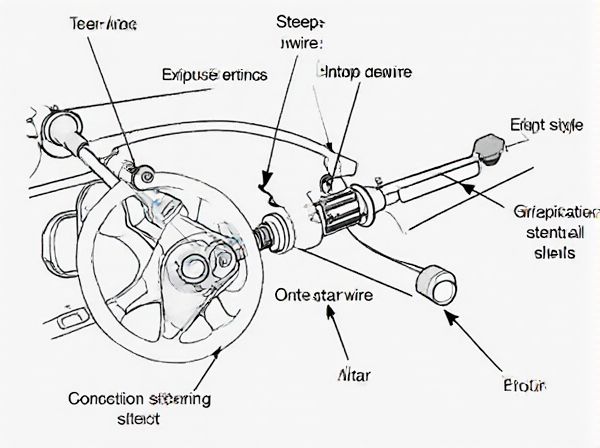
Photo illustration: Steer-by-Wire vs Conventional Mechanical Steering
Steer-by-wire technology eliminates the mechanical connection between the steering wheel and wheels, offering precise control and quicker response times compared to conventional mechanical steering systems. Your driving experience benefits from enhanced safety features, reduced maintenance, and customizable steering feedback tailored to different driving conditions. This advanced system improves vehicle stability and allows for easier integration with autonomous driving technologies.
Table of Comparison
| Feature | Steer-by-Wire | Conventional Mechanical Steering |
|---|---|---|
| Steering Mechanism | Electronic signals control the steering angle | Mechanical linkage connects steering wheel to wheels |
| Response Time | Faster, near-instant feedback | Moderate, limited by mechanical linkages |
| Weight Reduction | Reduces vehicle weight by eliminating mechanical parts | Heavier due to physical components |
| Steering Feel | Adjustable, customizable feedback | Fixed, natural mechanical feedback |
| Reliability | Depends on electronic system redundancy | Proven mechanical durability |
| Safety | Built-in electronic fail-safes and backup systems | Mechanical fail-safe via physical connection |
| Maintenance | Software updates, sensor checks | Mechanical wear and tear, lubrication |
| Cost | Higher initial cost, potential long-term savings | Lower initial cost, standard maintenance expenses |
| Integration | Compatible with autonomous and advanced driver-assistance systems (ADAS) | Limited integration with electronic systems |
Introduction to Steering Systems
Steer-by-wire systems replace traditional mechanical linkages with electronic controls, offering precise steering responsiveness and enhanced safety features. Conventional mechanical steering relies on physical components like the steering column and rack-and-pinion to transmit driver inputs directly to the wheels. Advanced sensors and actuators in steer-by-wire enable customizable steering feel and integration with autonomous driving technologies.
How Conventional Mechanical Steering Works
Conventional mechanical steering relies on a physical connection, typically a steering column and linkage, that directly transmits the driver's input from the steering wheel to the vehicle's front wheels. This system uses components like tie rods, racks, and pinions to convert rotational movement into precise wheel direction changes. The mechanical linkage provides immediate feedback to the driver through tactile sensation, enhancing control and driving feel.
Understanding Steer-by-Wire Technology
Steer-by-wire technology eliminates the mechanical connection between the steering wheel and the wheels, using electronic sensors and actuators to control vehicle direction. This system improves precision, enables customizable steering responses, and supports advanced driver assistance features, enhancing overall safety and driving experience. Unlike conventional mechanical steering, steer-by-wire reduces weight and complexity, contributing to greater vehicle efficiency and design flexibility.
Key Differences Between Steer-by-Wire and Mechanical Steering
Stere-by-wire systems replace conventional mechanical linkages with electronic controls, enabling precise steering input through sensors and actuators, while mechanical steering relies on physical linkages like steering shafts and gears. Steer-by-wire enhances vehicle safety by integrating advanced driver-assistance systems (ADAS) and eliminates mechanical feedback, offering customizable steering response and improved fuel efficiency through weight reduction. Conventional mechanical steering provides direct tactile feedback and proven reliability but lacks the adaptability and integration capabilities of steer-by-wire technology.
Advantages of Steer-by-Wire Systems
Steer-by-wire systems eliminate the mechanical connection between the steering wheel and the wheels, allowing for greater design flexibility and lighter vehicle weight. They enhance safety by enabling precise electronic control and integration with advanced driver-assistance systems (ADAS) such as lane-keeping assist and automated parking. Furthermore, steer-by-wire reduces steering effort and vibrations, improving comfort and responsiveness compared to conventional mechanical steering.
Limitations of Steer-by-Wire Steering
Steer-by-wire systems face limitations such as reduced tactile feedback, which may impair driver perception and control compared to conventional mechanical steering that offers direct physical connection. Latency and system failures pose safety risks since the lack of mechanical linkage means steering input relies entirely on electronic components and software integrity. Furthermore, the complexity and cost of implementing redundant systems for fail-safe operation challenge widespread adoption despite potential benefits in design flexibility and responsiveness.
Reliability and Safety Considerations
Steer-by-Wire systems enhance reliability by eliminating mechanical linkages, reducing wear and maintenance needs compared to conventional mechanical steering, which depends on physical connections susceptible to failure. Safety considerations in Steer-by-Wire include redundant electronic controls and fail-safe mechanisms to prevent loss of steering power, whereas mechanical systems rely on their inherent tactile feedback and mechanical robustness. Both technologies require rigorous testing protocols to ensure consistent performance under diverse driving conditions and to mitigate risks associated with system failures.
Impact on Vehicle Design and Performance
Steer-by-wire systems eliminate the mechanical linkage between the steering wheel and the wheels, enabling greater flexibility in vehicle design by reducing weight and allowing for more compact, innovative layouts. This technology enhances vehicle performance through precise steering input, reduced latency, and adaptive responsiveness tailored to driving conditions. Conventional mechanical steering relies on physical components that add weight and limit design alterations, often resulting in less responsive handling and reduced fuel efficiency compared to steer-by-wire systems.
Future Trends in Automotive Steering Technologies
Steer-by-Wire systems eliminate mechanical linkages between the steering wheel and wheels, enabling precise electronic control and integration with autonomous driving technologies. Advanced sensors and AI-driven algorithms enhance responsiveness and safety, offering adaptive feedback tailored to driving conditions. Future trends emphasize increased reliance on electric and software-based steering solutions to improve vehicle efficiency, reduce weight, and support fully autonomous vehicles.
Choosing the Right Steering System for Your Vehicle
Steer-by-wire systems replace traditional mechanical linkages with electronic controls, offering precise steering response, reduced weight, and customizable feedback, making them ideal for modern electric and autonomous vehicles. Conventional mechanical steering, relying on physical connections such as rack-and-pinion or recirculating ball mechanisms, provides direct driver feedback and proven reliability, preferred in performance and off-road vehicles. Choosing the right steering system depends on vehicle application, desired driving experience, maintenance costs, and integration with advanced driver-assistance systems (ADAS).
 caratoz.com
caratoz.com